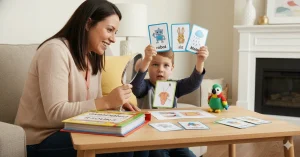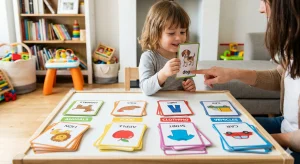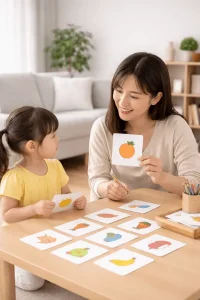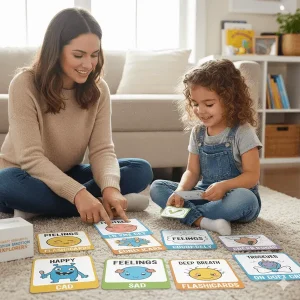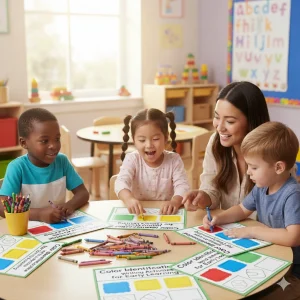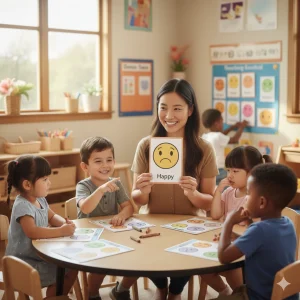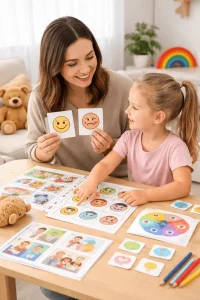Still Face Syndrome in Children: Signs & How to Help
Last Updated: October 1, 2024
What is Still Face Syndrome?
Imagine playing peek-a-boo with a baby and suddenly stopping to maintain a still face, devoid of any expression. Most babies would react with surprise or confusion. However, children with Still Face Syndrome might exhibit a different response. Instead of smiling back, making eye contact, or engaging, they may appear unresponsive, looking away or remaining silent. This behavior can indicate difficulties in social and emotional connection.
Why Parents Should Know
Every parent wants their child to be happy, connected, and emotionally healthy. Understanding and spotting Still Face Syndrome early is important because it helps ensure your child develops strong social and emotional skills. Early recognition means you can take steps to help your child learn to engage, communicate, and grow in a way that makes them feel connected to the world around them.
Children who show signs of Still Face Syndrome may find it harder to build those crucial early bonds or express their emotions. But don’t worry—knowing what to look for and how to support them can make a big difference. This article will guide you through what to watch for, how to manage it, and practical tips you can use to help your child thrive.
Also Read: How Still Face Syndrome Affects Your Child’s Emotional Health
How Still Face Syndrome Impacts Development.
The way your child interacts with you and others shapes their world. Social interaction helps them understand emotions, communicate their needs, and build relationships. If they show signs of Still Face Syndrome, it might mean they need a little extra support to develop these vital skills.
Spotting the Signs: How to Identify Still Face Syndrome
Recognizing Still Face Syndrome early is key to helping your child build healthy emotional connections. But what should you look for? Let’s dive into some of the common symptoms and signs that parents and caregivers can keep an eye out for.
Key Symptoms to Watch For
Most babies are naturally expressive. They make eye contact, smile back when you smile at them, and react to your voice or facial expressions. However, when a child shows signs of Still Face Syndrome, their responses may look a bit different. Here are some things to watch for:
- Lack of Eye Contact: One of the earliest signs is limited or inconsistent eye contact. A typical baby will often look into your eyes when you talk or smile. If your baby tends to look away or avoids eye contact altogether, this might be a red flag.
- Reduced Smiles or Laughter: Babies usually respond to their parents’ smiles with smiles of their own, or even giggles. If your child rarely smiles back or seems to have a “flat” expression, it could be a sign of Still Face Syndrome.
- Delayed or Limited Responses: Pay attention to how your child responds when you talk, play peek-a-boo, or make funny faces. If their reactions seem delayed, minimal, or they don’t respond much at all, it might indicate a difficulty in engaging socially.
- Inconsistent Emotional Expressions: Children with Still Face Syndrome may show fewer emotional reactions, making it harder to understand their mood or feelings. If they don’t appear excited when you play with them or rarely show joy, these could be signs to explore further.
Normal Behaviors vs. Signs of Still Face Syndrome
| Behavior | Normal Development | Signs of Still Face Syndrome |
|---|---|---|
| Eye Contact | Babies naturally hold eye contact while interacting with caregivers. They track movements and look into your eyes when you talk or smile. | May avoid making eye contact or only hold it briefly. May often look away or seem uninterested in faces. |
| Smiling | Smiles or giggles when smiled at; typically responds with joy when someone engages playfully, showing excitement and happiness. | Rarely smiles back even when you smile at them. May have a “flat” or neutral expression when playing or interacting. |
| Reacting to Voices | Babies usually respond to familiar voices with sounds, coos, or movements. When their name is called, they may turn their head, look excited, or make vocal sounds. | Slow to respond to voices or name being called. Might show little or no reaction to familiar sounds and voices, making it hard to engage them in conversation. |
| Emotional Expression | Shows a variety of facial expressions—joy, surprise, curiosity, and sometimes frustration. Their face changes with different emotions, which they express clearly. | Limited emotional range, often with flat or neutral expressions. May not show excitement, joy, or curiosity in response to new experiences or faces. |
Understanding the Causes of Still Face Syndrome.
Why Does Still Face Syndrome Happen?
When trying to understand Still Face Syndrome, it’s natural to ask: “Why is this happening to my child?” While there isn’t a single cause, there are a few factors that can contribute to a child’s reduced social and emotional response. Let’s break down a few possibilities.
- Limited Face-to-Face Time: Babies learn so much about the world through their caregivers’ faces. They observe your eyes, your smile, and the way your face changes with different emotions. If a baby doesn’t have enough opportunities for face-to-face interaction—whether because of a busy household, lack of quality time, or other reasons—it can impact how they respond to social cues.
- Emotional Environment: A child’s emotional world is largely shaped by their surroundings. If the environment is frequently stressful, chaotic, or emotionally distant, a baby might struggle to learn how to express emotions. It’s important to create a loving, stable, and emotionally supportive atmosphere so your child feels safe to engage and connect.
- Screen Time Exposure: In today’s digital world, screens are everywhere, and it’s easy to let babies spend time with a tablet or phone. But too much screen time can limit their face-to-face interactions and hinder their social and emotional development. Instead of learning to recognize real-life facial expressions and emotions, they might become overly focused on digital images and sounds.
How Environment Affects Behavior
The environment in which your child grows plays a huge role in how they learn to connect and respond to others. Here’s how a few aspects can shape their behavior:
- Caregiver Interaction: Babies are like sponges—they soak up everything you do. When you smile, talk, and play with your child, you’re teaching them how to communicate and show their emotions. If a caregiver is less responsive, perhaps due to stress, lack of time, or other factors, the baby might find it harder to engage.
- Consistency and Routine: A predictable and consistent environment helps a child feel secure. Babies thrive on routines—they find comfort in knowing what comes next. When the environment is inconsistent or overwhelming, it can affect their ability to respond to social cues and may contribute to signs of Still Face Syndrome.
Easy Tips to Manage and Improve Still Face Syndrome
If you’ve spotted signs of Still Face Syndrome in your child, don’t worry—there are many simple and fun ways to help improve their social and emotional engagement. Here are a few easy tips that you can incorporate into your daily routine to support your child’s development.
Interactive Play & Games
Children learn best through play, especially when it comes to social and emotional skills. Engaging in simple, interactive games can make a big difference. Here are some playful activities that encourage connection:
- Peek-a-Boo: A classic and simple game like peek-a-boo does wonders for social engagement. Hide your face behind your hands, then reveal it with a big smile! Babies usually love this, and it helps them learn how to react to expressions and enjoy face-to-face interactions.
- Mirror Play: Sit with your child in front of a mirror and make funny faces together. You can smile, stick your tongue out, or make silly expressions. This helps them learn to recognize different emotions and expressions in a fun way.
- Copycat Games: Mimicking each other’s sounds, facial expressions, or actions is a great way to engage your child. For example, if they make a “ba-ba” sound, repeat it back to them. If they clap their hands, clap back. This back-and-forth helps build strong social connections.
Remember, the goal is to have fun together while encouraging your child to explore their emotions and reactions.
Be Present & Responsive
Your presence is the best gift you can give your child when it comes to helping them with Still Face Syndrome. Being present means truly engaging with your child, focusing on them without distractions. Here’s how you can do it:
- Eye Contact & Smiling: Whenever you talk to your baby, look into their eyes and smile. It might seem small, but eye contact and warm facial expressions go a long way in making your child feel seen and connected.
- Responsive Play: If your child coos, babbles, or makes any noise, respond to them. Turn it into a conversation, even if it’s just repeating what they said or saying something like “Yes! Tell me more!” This responsiveness teaches your child that their emotions and words matter, boosting their confidence to interact more.
- One-on-One Time: Take a few minutes each day for dedicated one-on-one time with your child, away from distractions. Whether it’s cuddling, singing songs, or just talking to them, these moments build stronger emotional bonds and improve their social development.
Limit Screen Time
While it might be tempting to use screens to entertain your little one, too much screen time can take away opportunities for face-to-face interactions. Here are some simple ways to balance screen use and real-world connections:
- Set Screen-Free Zones: Create special times or areas in your home that are screen-free. For example, mealtimes or playtimes can be screen-free, allowing more opportunities for talking, smiling, and playing together.
- Encourage Real Play Over Digital Play: Instead of handing your child a tablet or phone, encourage them to explore their surroundings. Offer toys, books, or simply play with them. Real-world play helps your child learn to respond to real faces, voices, and emotions.
- Be a Role Model: Babies and young children often copy what they see. If they notice you constantly on your phone, they’re more likely to seek screen time too. Set an example by putting your devices away when spending quality time with them.
Supporting Your Child’s Social Journey
The Power of Positive Reinforcement
Children love attention and praise—it helps them feel valued and encourages them to repeat good behaviors. Positive reinforcement is all about recognizing and celebrating your child’s efforts to engage socially, even in the smallest ways.
When your child makes eye contact, smiles back, or reaches out to communicate, let them know you’re happy! A simple “Wow, that was such a great smile!” or “You’re doing such a good job looking at mommy/daddy!” can make a world of difference. Your encouragement builds their confidence, making them more eager to engage and connect with others.
Positive reinforcement doesn’t have to be big or complicated. Smiling back, clapping, or giving a gentle hug whenever your child interacts with you shows that their actions are appreciated. The more they are praised for positive social behaviors, the more they’ll want to keep practicing them.
Building a Safe, Engaging Environment
Every child needs a safe, loving space to grow, explore, and express their emotions. The environment you create at home plays a huge role in helping your child develop social skills and emotional security. Here’s how you can make it happen:
- Create a Warm Atmosphere: A warm, loving atmosphere means giving your child the freedom to express themselves without fear. This means responding to their needs, comforting them when they are upset, and showing affection regularly. When a child feels secure, they are more open to exploring their surroundings and interacting with others.
- Encourage Exploration and Curiosity: Give your child the chance to explore and learn. Provide toys, books, and sensory activities that help them discover their world. Whether it’s exploring different textures with a soft toy or listening to your voice while you read a book, each experience helps your child learn to communicate and connect.
- Be Patient and Supportive: Children learn social skills at their own pace. If they’re shy or hesitant at first, that’s okay. Encourage them gently and provide comfort and support as they explore new ways to connect with you and others.
Conclusion
Raising a child is a journey filled with love, learning, and lots of little discoveries. Understanding Still Face Syndrome and knowing how to recognize its signs can help you support your child’s social and emotional growth. Keep an eye out for signs like limited eye contact, fewer smiles, and delayed responses. Knowing what might cause these behaviors, like too much screen time or a stressful environment, is also helpful. Simple, fun activities like interactive play, lots of face-to-face time, and positive reinforcement can make a big difference in helping your child connect and express themselves.
Every child grows and learns at their own pace, and your support plays a huge role in their development. By being loving, present, and responsive, you’re guiding your child to build confidence and stronger social skills. Remember, if you need more advice or resources on child development, Wellness Hub is here to help you find the right tools and information for your child’s journey. With the right approach, your child can thrive emotionally and socially, ready to take on the world with a smile.
Frequently Asked Questions:
1. What is Still Face Syndrome in children?
Still Face Syndrome is when a child shows reduced emotional responses or struggles to engage socially with others. It may include less eye contact, fewer smiles, and minimal reactions to faces or voices.
2. How can I identify signs of Still Face Syndrome in my child?
Look for signs like lack of eye contact, limited smiling, delayed responses, and reduced interest in social interactions. These behaviors can be spotted as early as 6 months of age.
3. What causes Still Face Syndrome?
Possible causes include limited face-to-face time with caregivers, a stressful emotional environment, and too much screen time. These factors may affect a child’s ability to connect and respond socially.
4. At what age can I start noticing symptoms of Still Face Syndrome?
Symptoms can typically be noticed around 6 months of age, as this is when babies usually begin to respond more to facial expressions and social interactions.
5. How can I help my child if they show signs of Still Face Syndrome?
You can engage in interactive play, maintain face-to-face contact, reduce screen time, and use positive reinforcement to encourage emotional and social engagement.
6. How does screen time affect social development in children?
Excessive screen time can limit face-to-face interactions, which are crucial for social development. Reducing screen time and encouraging real-world play can help improve a child’s social skills.
7. Why is positive reinforcement important for children with Still Face Syndrome?
Praising and encouraging social interactions can build your child’s confidence, making them more willing to engage and respond emotionally, helping them develop better social skills.
8. Is Still Face Syndrome related to autism?
While some behaviors may appear similar, Still Face Syndrome is not the same as autism. However, if you notice persistent signs of reduced social engagement, it’s always best to consult a professional for a thorough assessment.
9. Can my child outgrow Still Face Syndrome naturally?
With support, such as interactive play, responsive caregiving, and reduced screen time, many children show improvement. Early intervention can significantly help in boosting their social and emotional development.
10. Where can I find more resources to support my child’s development?
For expert advice and resources on child development, you can visit Wellness Hub, where you’ll find guidance tailored to help your child grow socially and emotionally.
About Author:
Lasya Vooturi,
Clinical Psychologist (A) & Behavioral Therapist
Lasya holds a Professional Diploma in Clinical Psychology from Amity University, where she deepened her understanding of psychological principles from March 2023 to March 2024. With over a year of dedicated experience as a Behavioral Therapist, Lasya has honed her skills in applying effective therapy techniques tailored to individual needs. Fluent in Telugu, Hindi, and English, she is adept at connecting with a diverse range of clients, ensuring comprehensive communication and understanding. Lasya’s approach is grounded in empathy and scientific rigor, making her a trusted ally in navigating mental health challenges.
Book your Free Consultation Today
Parent/Caregiver Info:
Client’s Details:
* Error Message

